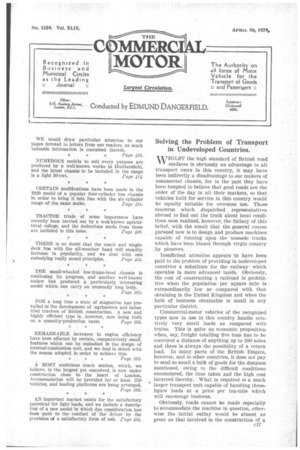Solving the Problem of Transport in Undeveloped Countries.
Page 47

Page 48

If you've noticed an error in this article please click here to report it so we can fix it.
WHILST the high standard of British road surfaces is obviously an advantage to all transport users in this country, it may have been indirectly a disadvantage to our makers of commercial chassis, for in the past they have been tempted to believe that good roads are the order of the day in all their markets, so that vehicles built for service in this country would be equally suitable for overseas use. Those concerns which dispatched representatives abroad to find out the truth about local conditions soon realized, however, the fallacy of this belief, with the result that the general course pursued now is to design and produce machines capable of running upon the unmade tracks which have been blazed through virgin country by pioneers.
Insufficient attention appears to have been paid to the problem of providing in undeveloped countries a substitute for the railway which operates in more advanced lands. Obviously, the cost of constructing a railroad is prohibitive when the population per square mile is extraordinarily low as compared with that obtaining In the United Kingdom and when the bulk of business obtainable is small in any particular district.
Commercial-motor vehicles of the recognized types now in use in this country handle relatively very small loads as compared with trains. This is quite an economic proposition when, say, freight totalling five tons has to be conveyed a distance of anything up to 200 miles and there is always the possibility of a return load. In many parts of the British Empire, however, and in other countries, it does not pay to send so small a bulk of goods for the distance mentioned, owing to the difficult conditions encountered, the time taken and the high cost incurred thereby. What is required is a much larger transport unit capable of handling threefigure loads at a price per ton-mile which will encourage businesS.
Obviously, roads cannot lite made especially to accommodate the machine in question, otherwise the •initial outlay would be almost as great as that involved in the construction of a railroad. This meahs that the vehicle must travel over existing surfaces and be able to maintain a reasonable average speed without fear of becoming stranded. Naturally, a course must be chosen which avoids swamps or other natural phenomena that would certainly give rise to trouble.
. From this it will be gathered that even the multi-wheeled vehicle is not in its element for the work named, the track-laying machine being the most obvious solution.
A further consideration is the availability of fuel. Petrol is ruled out in a large number of cases by reason of its high price. The use of producer-gas, manufactured from local material, is an avenue open to exploration, whilst the compression-ignition engine using non-vaporizing liquid fuel possesses many advantages, among which is the comparatively small weight of fuel required per b.h.p.-hour as compared with the more volatile liquids in common use to-day.
The problem—or rather the dual allied questions of tackling difficult surfaces and the utilization of an economic fuel—has already been faced by certain parties well known in the commercial-motor world, and a committee has been appointed to study the assistance which mechanical transport can give to the economic development of our Empire overseas. From what we have seen of the plans and designs, the vehicles which are projected will be of a type possessing extreme interest to all students of transport and should do much to show that British industry is not lagging behind that existing in other lands. The evolution of the scheme will be watched with interest and we shall keep our readers informed of the developments as they occur.
Defining the Electric Vehicle.
ASIGNIFICANT paragraph in the Budget proposals refers to the duties charged on electrically propelled vehicles and reads as follows :—" It is proposed to provide that for the purpose of the duties charged on mechanically propelled vehicles a vehicle shallnot be deemed to be an electrically propelled vehicle unless the electrical motive power is derived either from a source external to the vehicle or from an electric storage battery which is not connected with any source of power when the vehicle is in motion."
This is obviously inserted with the object of overcoming the difficulty which arose in the later months of last year, when the maker of a petrol:electric vehicle finally won a decision in a long-protracted case referring to the inclusion of this type of vehicle under the category "electrically propelled," thus considerably reducing the amount of tax payable as compared with that charged on a vehicle propelled by an internal-combustion engine.
We were quite sure at the time that the Chancellor would not let this state of affairs exist for long, but we believe that users of these • petrol-electric vehicles reaped some advantage, in that they could claim for the excess duty paid previous to the date of this alteration.
We rather regret this return to the status quo, for the reason that we consider the petrolelectric class of vehicle deserves some such measure of encouragement, for it is an ideal type for certain work, running delightfully smoothly and being altogether free from any possible jars and shocks from gear changing.




























































































































